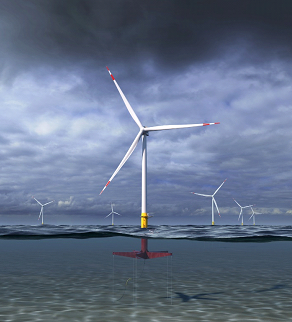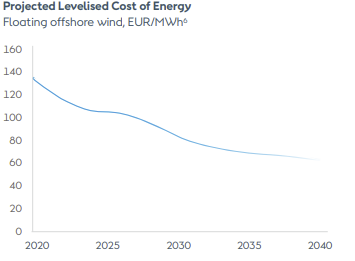Floating Wind Power, a reason to be buoyant


· 7 min read
On Sunday the 13th of November, the largest floating wind farm in the world started operations. It is run by Norwegian energy firm Equinor, and is slated to produce 88 MW once the last 4 turbines have been installed in 2023 (1).

What is so special about this wind farm is not its power output but rather the ocean depth beneath, standing at 260-300 m deep. This is unprecedented for an offshore wind farm. Traditional, seabed-installed, offshore wind turbines, are considered economically viable only when the water is shallower than 60 m despite at most 7% of the worlds oceanic surface being shallower than 200 m (2). Consequently, more than 80% of potential global ocean wind energy has been out of reach.
That is where floating wind farms come in. The relatively new technology is based on offshore wind turbines (the same way offshore turbines were inspired by onshore turbines), but the difference is around the turbines’ foundation. Regular offshore wind turbines have fixed foundations along the seabed. The ensuing technical challenge and expensive installation costs are behind the limited water depth. Floating wind turbines, meanwhile, are built on steel or concrete platforms buoyed by large ballasts. These can vary in shape and length and serve to counteract the tipping and rotating moments caused by the wind turbines. They are then moored to the seabed with long cables (3).
On account of this difference, floating wind farms can be installed in areas of much greater depth. Current technology suggests the exploitable water depth for floating wind farms will range from 60 m to 800 m (although the latter is still out of reach). Floating wind farms will thus be able to tap into a substantial here-to-fore inaccessible energy source, opening countries and geographies with deeper coastal water to offshore wind power. The ‘Offshore Wind Outlook of 2019’, a report by the International Energy Agency, suggests that floating offshore wind could capture 336 000 TWh per year (4) from the total potential of global offshore wind energy. That is 14 times the global electricity usage of 2019, standing at around 23 000 TWh, and more than 4 times the predicted use of 2050 (5).
Not only will floating offshore wind technology allow for greater areas of exploitation, it is also expected to be more efficient than regular offshore wind turbines. Being further from shore should allow the turbines to have larger blades, increasing their maximum power output. Moreover, winds across open ocean are both stronger and less intermittent. This dually increases power generation potential and decreases fluctuations throughout the day, resulting in an efficiency of 45-50% for fixed offshore wind turbines while reaching 50-60% for floating offshore wind (6). This is in line with the conclusions from the world’s first floating wind farm, Hywind Scotland. The farm boasted an average capacity factor of 57.1% in a 12 month period which makes it the best performing offshore wind farm in the UK three years running (7). By comparison, the average capacity for offshore wind in the UK is 40%. These benefits suggest floating wind power can play a big role in the transition to greener energy production.
Understandably, growth is expected in the sector. In 2021, 21.1 GW of offshore wind was added, the biggest increase in a year to date (8). Total offshore installations represent 7% of worldwide installed wind energy, growing year on year. The share of new wind energy installations offshore wind represents is expected to rise from 23% in 2021 to 30% in 2031, by the Global Wind Energy Council (GWEC). By then, it is thought that 370 GW of offshore wind will have been installed, 18.9 GW of which will be floating wind energy. Of those, 11 GW will be in Europe, a value 100 times higher than the currently installed capacity (9).

The ambitions for the sector are highlighted by the current project pipeline of global floating offshore wind power. Around 120 GW are being developed driven by initiatives in Europe, the US and Asia (8). The Equinor project mentioned earlier will soon be dwarfed. Equinor is already planning another floating offshore wind farm off the coast of Norway titled Wind Semi, with a target capacity of 1 000 MW (9). Similarly, a project in Korea, KFWind, has started development and aims to install 1 000 MW of floating offshore wind power (10) as a part of the government’s goal to generate 4.6 GW with this method by 2026 (11). Others like project Salamander from Simply Blue, and Stromar, which has Ørsted’s involvement, collectively aim to develop 1 200 MW off the coast of Scotland (12).
Encouragingly, both China and the US are also taking notice. China has already taken the lead over Europe in offshore wind capacity by installing 17 GW in 2021 (80% of added capacity that year) and now accounts for 26 GW, more than half of the total 54 GW of offshore wind installed worldwide (13). The country has been testing different floating wind projects, and is believed to be aiming to set up a 1 GW floating wind farm by 2027 (14). The United States, meanwhile, recently announced plans to develop 30 GW of offshore wind energy for 2035 in an attempt to meet its net-zero goals. The U.S. Department of Energy stated that two-thirds of U.S. offshore wind potential “[exists] over bodies of water too deep for ‘fixed-bottom’ wind turbine foundations.” (15) This might explain the pledge by the Biden-Harris administration to develop 15 GW of floating wind energy capacity to power 5 million homes. The US West Coast is a key opportunity, as seen in Figure 2. Olympic Wind is a project seeking to seize the opportunity, proposing to install 2 GW of floating offshore wind energy off the coast of Washington State for operational opening in 2030 (11).
The U.S. initiative is crucial because it comes alongside the ‘Floating Offshore Wind Shot.’ Quoting the Department of Energy, the ‘Floating Offshore Wind Shot’ is a funding opportunity that “aims to reduce the cost of floating technology by more than 70% by 2035,” thus seeking to tackle one of the greatest challenges facing floating offshore wind (15). That is to say, high costs. These are expected, yet achieving a competitive price per MWh is crucial for large scale adoption. Notably, onshore wind still dominates wind energy installations because it is a more mature technology and costs less at around $60/MWh than offshore wind generally at $100/MWh (16). However the growth rate of onshore wind is due to plateau while that of offshore wind is due to take off as the technology matures and becomes cheaper. The shift has already begun, with the cost of fixed-offshore wind decreasing to $78/MWh in 2019 (17). Floating offshore wind should follow the same trajectory, as highlighted in Figure 3, with the GWEC estimating that the technology will reach full commercialisation by 2030 (18).

Additional challenges include maintenance. The process is tricky because the turbines are not fixed. While some could be hauled back to port for repairs, that will be location dependent. In many cases the turbines will need to be serviced by vessels that will also be floating. Using a large crane to replace a component like a turbine blade (the largest offshore turbine blade stands at 115 m in length (19)) while both platforms are floating independently in open seas is a challenge that the industry is currently addressing through the Floating Wind Joint Industry Project (FWJIP), a group that aims to deal with issues of collective interest (3).
Finally, the environmental impacts of floating wind turbines remain to be investigated. Being further from coasts, it is believed that they would be out of the way of bird feeding grounds and migration routes. Their installation is also thought to be less disruptive to surrounding sea-life as there is no underwater drilling required during installation, and the turbines can instead be assembled entirely at port (12). Nevertheless the novelty of the technology means that its long-term impact on marine ecosystems will need to be evaluated over time.
Ultimately, floating offshore wind energy is a fast growing technology with a significant potential impact on world electricity production. While some issues remain to be ironed out on the path to wider adoption, governments and industry have taken notice and momentum is building. Assuming everything goes to plan, floating offshore wind energy will make a consequential contribution towards countries reaching their net-zero goals.
Future Thought Leaders is a democratic space presenting the thoughts and opinions of rising Sustainability & Energy writers, their opinions do not necessarily represent those of illuminem.
1. https://www.cnbc.com/2022/11/14/the-worlds-largest-floating-wind-farm-produces-its-first-power.html.
2. https://www.whoi.edu/know-your-ocean/.
4. https://www.iea.org/reports/offshore-wind-outlook-2019.
5. https://www.iea.org/reports/net-zero-by-2050.
6. https://akeroffshorewind.com/expertise/.
8. https://gwec.net/gwecs-global-offshore-wind-report/.
9. https://www.wired.co.uk/article/floating-wind-turbines.
10. https://www.principlepower.com/projects/korea-floating-wind.
11.https://www.eenews.net/articles/company-proposes-largest-offshore-wind-farm-on-west-coast/.
12. https://orsted.com/en/insights/white-papers/floating-wind.
13. https://electrek.co/2022/10/22/china-offshore-wind/.
14. https://www.aegirinsights.com/news/china-may-build-the-worlds-first-1-gw-floating-wind-project.
17. https://en.wikipedia.org/wiki/Offshore_wind_power.
18. https://gwec.net/gwec-offshore-wind-will-surge-to-over-234-gw-by-2030-led-by-asia-pacific/.
19. https://www.designboom.com/technology/siemens-gamesa-longest-wind-turbine-blade-to-date-06-03-2022/.
21. https://orsted.com/en/media/newsroom/news/2022/08/20220831559011.
Steven W. Pearce

Adaptation · Mitigation
illuminem briefings

Corporate Governance · Adaptation
illuminem briefings

Sustainable Finance · ESG
Devex

Sustainable Finance · Adaptation
Sustainable Views

Sustainable Finance · Adaptation
Politico

Climate Change · Agriculture